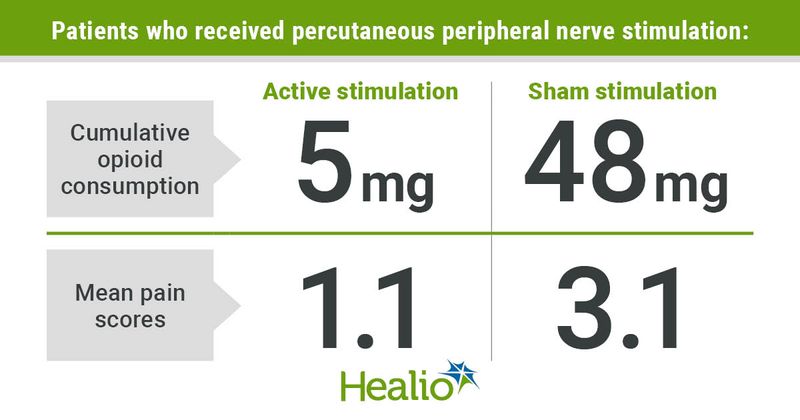Peripheral nerve stimulation associated with reduction in pain scores, opioid consumption
Active, percutaneous peripheral nerve stimulation reduced pain scores and opioid requirements without side effects during the first 7 days after ambulatory orthopedic surgery, according to published results.
“Postoperative pain management relies primarily on pharmacologic approaches with limited effectiveness,” Brian M. Ilfeld, MD, and colleagues wrote in the study. “Peripheral nerve stimulation is effective in controlling some forms of chronic pain but has not been tested in the postoperative setting,” they added.

To determine the treatment effect of percutaneous peripheral nerve stimulation on postoperative pain and opioid consumption, Ilfeld and colleagues analyzed 32 patients who were randomly assigned to 14 days of active electrical stimulation and 34 patients randomly assigned to sham stimulation that used an external pulse generator in a double-masked fashion. Outcome measures included cumulative opioid consumption (measured in oral morphine equivalents) and daily pain scores during the first 7 days after surgery (measured from 0 to 10 using the numeric rating scale), according to the study.
Ilfeld and colleagues found both opioid consumption and mean pain scores were reduced by active, percutaneous peripheral nerve stimulation compared with the sham stimulation treatment.
According to the study, opioid consumption in the active stimulation cohort was a median of 5 mg compared with 48 mg in the sham stimulation cohort. Likewise, mean pain score in the active cohort was 1.1 ± 1.1 compared with 3.1 ± 1.7 in the sham cohort.
“This multicenter, randomized, double-masked, sham-controlled pilot study provides evidence that ultrasound-guided percutaneous peripheral nerve stimulation concurrently improves analgesia and decreases opioid requirements to a statistically significant and clinically meaningful degree for at least a week after moderately to severely painful ambulatory orthopedic surgery,” Ilfeld and colleagues concluded.

